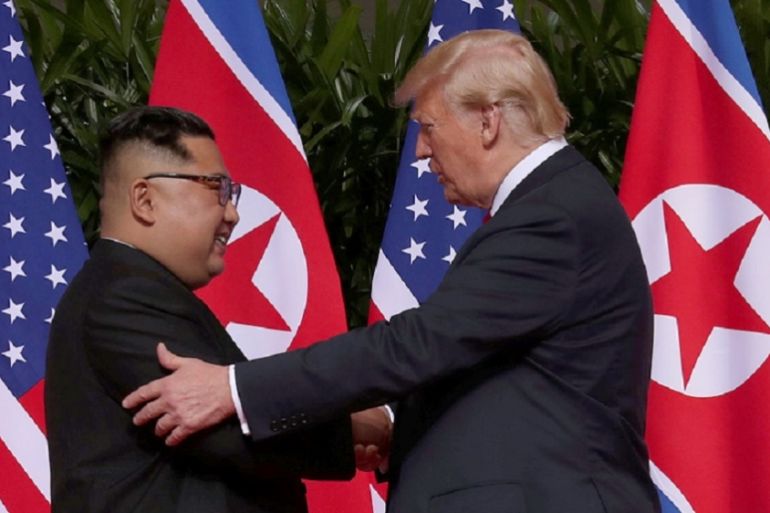One big reason North Korea is not too eager to denuclearise
Past experience.

One of the most significant foreign policy challenges the international community is currently facing is the denuclearisation of North Korea.
The good news is that North Korean leader Kim Jong Un committed “to work toward complete denuclearisation of the Korean Peninsula” in June this year, following his historic summit with US President Donald Trump in Singapore.
Keep reading
list of 4 itemsRepublican congressman suggests nuking Gaza
UK’s Sunak to unveil $252m investment in nuclear deterrent, nuclear energy
Why are the US and Japan pushing to ban nuclear weapons in space?
Since then, as an act of good faith, President Trump halted the US-South Korea joint military exercises that North Korea views as provocative. In return, North Korea stopped testing its nuclear bombs and the missile systems that deliver them and even dismantled a key missile test site.
However, none of this will be enough in the long term. For the world to be genuinely safe from the North Korean nuclear threat, and for President Trump to not look like a fool, Pyongyang should take concrete steps to eliminate all its nuclear weapons and capabilities. It should start rolling back its nuclear programmes according to a timetable and allow independent verification of the steps it will be taking.
This is not an easy task to accomplish. Twice before, in 1994 and 2007, agreements aiming to denuclearise North Korea were signed but failed to hold. Although, today, there seems to be a new momentum towards denuclearisation, there is one major challenge which is likely to prevent it: The experiences of other countries.
In 1994, Ukraine gave up the nuclear weapons and capacity that it had inherited from the Soviet Union. In 2003, Libya scrapped its programme to build weapons of mass destruction, even though it was only years away from completing a working nuclear weapon. In 2015, Iran agreed to halt its nuclear programmes, even though it was perhaps within a year of reaching its goal of making a nuclear weapon.
In each case, denuclearisation was accomplished through a similar path. First, concerned parties reached an agreement on what needed to be achieved. Second, they agreed on a timetable. Third, a reputable and independent global body, namely the International Atomic Energy Agency took on the responsibility of overseeing the process and verifying that the country in question is indeed keeping up with the agreed disarmament programme.
In every scenario, promises of compensation were made to the country that agreed to give up its nuclear capabilities in the form of either the lifting of national and international sanctions or the provision of benefits, such as in trade, technology, finance, energy and diplomacy. A complete normalisation of relations was promised on the condition of complete denuclearisation, and rewards were given after the completion of each step in the schedule.
On the surface, it seems this tried and tested blueprint can also work in North Korea. However, there is one undeniable fact that is making it hard for President Trump to use this straightforward strategy when dealing with Pyongyang: Kim Jong Un can clearly see that none of the aforementioned countries became any safer or more prosperous for giving up their nuclear weapons or potential. Moreover, parties to these agreements failed to uphold their promises.
In the case of Ukraine, Russia broke its 1994 pledge to “refrain from the threat or use of force against the territorial integrity or political independence of Ukraine” two decades later and annexed Crimea. It also played an active role in the Ukrainian civil war.
In the case of Libya, less than a decade after relinquishing his weapons of mass destruction, Muammar Gaddafi was violently toppled, with the support of the very same Western forces that applauded the Libyan leader for the decision and appeared – albeit briefly – to be his allies.
Finally, in the case of Iran, the promise that all parties would implement the Joint Comprehensive Plan of Action (JCPOA) in “good faith and in a constructive atmosphere, based on mutual respect, and to refrain from any action inconsistent with the letter, spirit and intent” was abandoned by the US as soon as there was a new president in the White House. Soon after he took office, despite Iran being in compliance with the agreement, President Trump quit JCPOA, leaving the Iranian economy in tatters.
What all of this means is that to achieve “complete denuclearisation of the Korean Peninsula”, President Trump will have to convince Chairman Kim Jong Un of three things:
First, that any agreement they reach will do more to secure the territorial integrity of North Korea than the 1994 Budapest Memorandum on Security Assurances did to protect the territorial integrity of Ukraine.
Second, that their new relationship will not be a charade – like the one between his predecessors and Libya’s Gaddafi – and that Washington will not wait for opportunities to topple Kim’s regime even after North Korea completes denuclearisation.
Third, that the US will hold its side of the deal, even after the end of Trump’s tenure – in other words, a guarantee that future US presidents will not do to North Korea what Trump did to Iran. None of these will be easy to achieve, as past actions speak louder than words.
The views expressed in this article are the author’s own and do not necessarily reflect Al Jazeera’s editorial stance.
